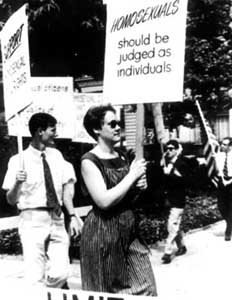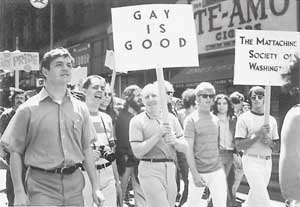feature
Completing the rainbow
Published Thursday, 05-Oct-2006 in issue 980
The list has one obvious flaw: diversity. The early stages of the gay rights struggle lacked minority activists for numerous reasons, chief being that people of color were waging an equally important battle for civil rights. And in many cases the gay community mirrored the social partisanship of the non-gay world until the cultural shift of the 1970s. The Gay Militants, the first book published discussing the early gay rights movement, lists 60 early activists, with only a handful of minorities present. Starting in the mid-’70s, that list would become more diverse, with more groups taking part and opening up to the idea of a gay rights struggle.
But there are notable individuals who have contributed to both gay rights and advancing their own roots. Women in our community have had a long history of leadership, and since gay social activities were limited up until the 1970s, the few existing bars and clubs welcomed all individuals regardless of gender. Many of those places were located in black neighborhoods like Harlem, whose similarly discriminated-against communities provided a safe haven from the police where gay men and women could discuss issues and relationships with some freedom.
One great example is Bayard Rustin. Rustin acted as key advisor to Martin Luther King Jr. in the ’60s, educating King on pacifist resistance and co-organizing the Southern Christian Leadership Council. He felt compelled to be open about his homosexuality, and informed King that he would resign if it hindered their work. King refused his offer, though the issue was kept quiet and was a feared secret in both the NAACP and the SCLC. Rustin was forced to resign his seat on the SCLC in 1960 to avoid a morals charge in Congress, and was furthermore scrutinized by Strom Thurmond in the Senate, who alleged that Rustin and King were intimately involved. Following King’s death, Rustin continued his work as an activist for Freedom House and promoted ties between the civil rights movement and the Democratic Party. In 1986, he spoke on behalf of the New York state Gay Rights Bill and urged gay and lesbian outreach to all minorities, to promote unity throughout the entire civil rights struggle.
James Baldwin, another noteworthy individual, made his mark on the literary industry long before the budding civil rights struggles of the 1960s. Growing up in Harlem from his birth in 1924 until he moved to Paris in 1948, Baldwin took both the gay and black communities under his wing as a writer. He published many essays discussing homophobia as well as racism, linking the two as a byproduct of humanity’s severe fragmentation. His most noteworthy books, including the novel Go Tell It on the Mountain, deal with his experience and reactions to the racial and sexual prejudice which plagued him during his youth. Even after his death in 1987, Baldwin continues to be a leading literary figure throughout the world and an inspiration to the gay community, in which he bravely took part.
Finally, we have Sylvia Rivera, one of the earliest and most influential members of the Gay Liberation Front and a vocal presence during the Stonewall riots. Rivera and friend Marsha P. Johnson started the Street Transvestite Action Revolutionaries (STAR), a direly needed resource for the transvestite community, which had often found itself shunned and excluded from the traditional gay and lesbian community. As one of the earliest trans activists, Rivera is one of the few transvestites who made a strong impact on the burgeoning civil rights movement. From her beginnings as a young Puerto Rican drag queen to her death in 2001, Rivera was a loud exception to the white-dominated GLBT movement.
Similar attitudes in the Latino and Asian communities, as well as in several religions, have spurred organizations and cultural groups that cater to previously ignored minorities within the community. And most welcome all individuals regardless of color or creed. With the support and strength of past and present pioneers and all parts of the gay and lesbian landscape, we have proven that the rainbow that defines our community holds true today, a testament to our unity and our achievement.
|
|
Copyright © 2003-2025 Uptown Publications






